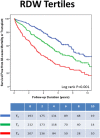Full blood count as potential predictor of outcomes in patients undergoing cardiac resynchronization therapy
- PMID: 31506584
- PMCID: PMC6736835
- DOI: 10.1038/s41598-019-49659-z
Full blood count as potential predictor of outcomes in patients undergoing cardiac resynchronization therapy
Abstract
Almost a third of patients fulfilling current guidelines criteria have suboptimal responses following cardiac resynchronization therapy (CRT). Circulating biomarkers may help identify these patients. We aimed to assess the predictive role of full blood count (FBC) parameters in prognosis of heart failure (HF) patients undergoing CRT device implantation. We enrolled 612 consecutive CRT patients and FBC was measured within 24 hours prior to implantation. The follow-up period was a median of 1652 days (IQR: 837-2612). The study endpoints were i) composite of all-cause mortality or transplant, and ii) reverse left ventricular (LV) remodeling. On multivariate analysis [hazard ratio (HR), 95% confidence interval (CI)] only red cell count (RCC) (p = 0.004), red cell distribution width (RDW) (p < 0.001), percentage of lymphocytes (p = 0.03) and platelet count (p < 0.001) predicted all-cause mortality. Interestingly, RDW (p = 0.004) and platelet count (p = 0.008) were independent predictors of reverse LV remodeling. This is the first powered single-centre study to demonstrate that RDW and platelet count are independent predictors of long-term all-cause mortality and/or heart transplant in CRT patients. Further studies, on the role of these parameters in enhancing patient selection for CRT implantation should be conducted to confirm our findings.
Conflict of interest statement
The authors declare no competing interests.
Figures
References
-
- Ponikowski P, et al. ESC Scientific Document Group. 2016 ESC Guidelines for the diagnosis and treatment of acute and chronic heart failure: The Task Force for the diagnosis and treatment of acute and chronic heart failure of the European Society of Cardiology (ESC) Developed with the special contribution of the Heart Failure Association (HFA) of the ESC. Eur. Heart. J. 2016;37(2200):2129. doi: 10.1093/eurheartj/ehw128. - DOI - PubMed
-
- Goldenberg I, et al. Reduction of the risk of recurring heart failure events with cardiac resynchronization therapy: MADIT-CRT (Multicenter Automatic Defibrillator Implantation Trial With Cardiac Resynchronization Therapy) J. Am. Coll. Cardiol. 2011;58:729–737. doi: 10.1016/j.jacc.2011.04.024. - DOI - PubMed
MeSH terms
LinkOut - more resources
Full Text Sources
Medical
Molecular Biology Databases
Research Materials
Miscellaneous



